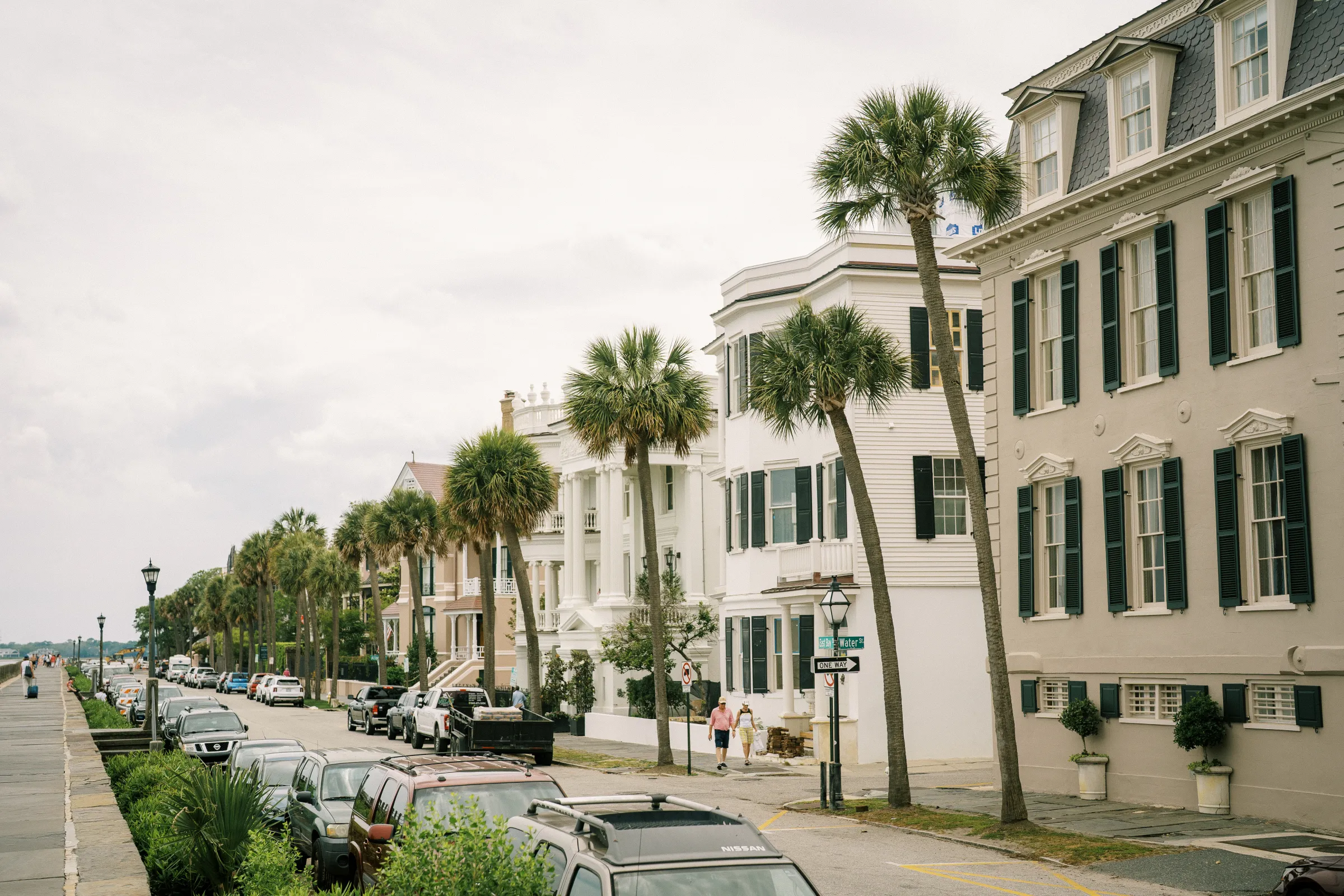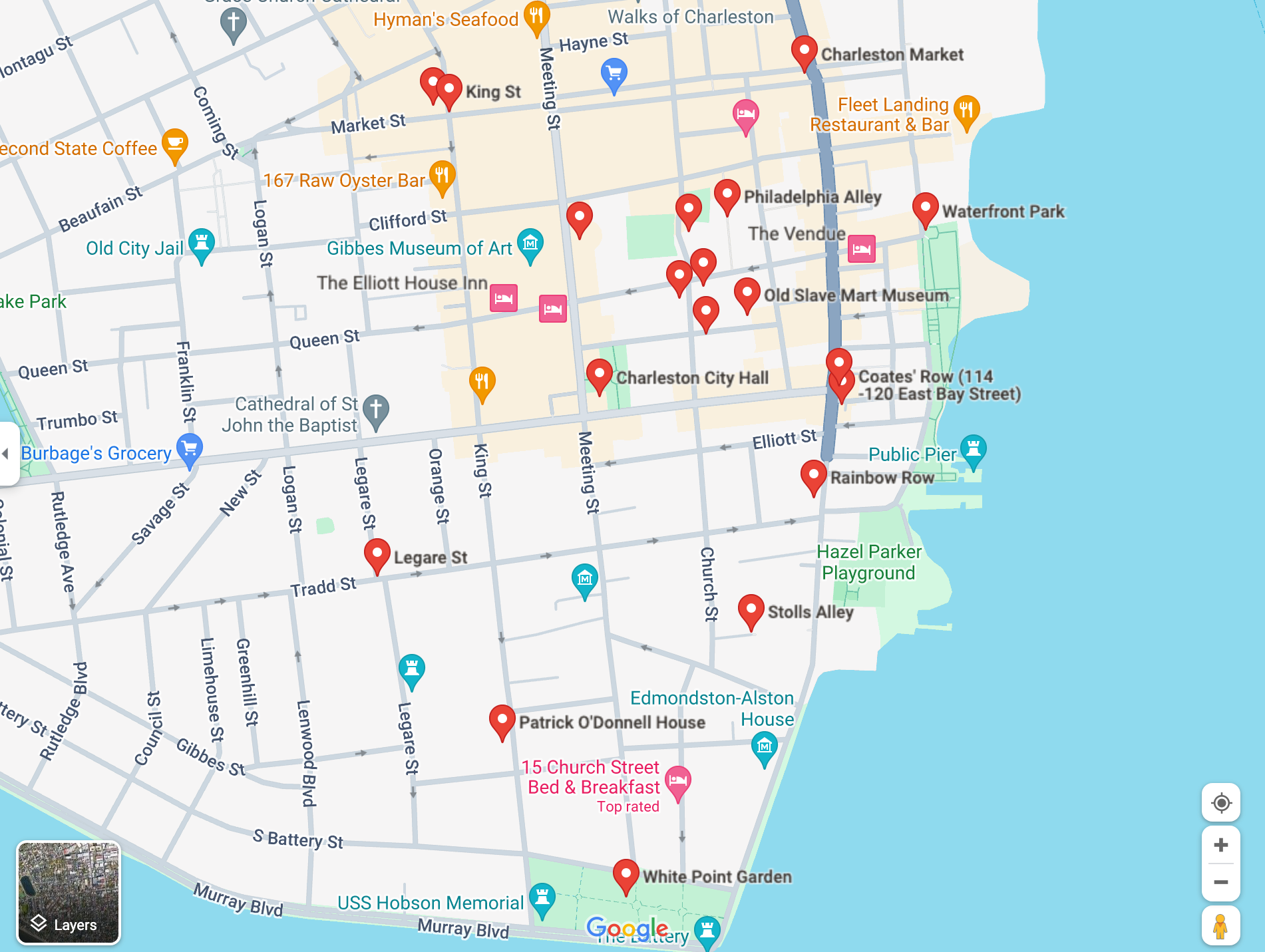Charleston Self-Guided Tours

Charleston’s history dates back to 1670, when English colonists founded it. Luckily, it has retained much of its culture, monuments, and original architecture over the years. Walking down the streets of Charleston, you feel as though you’re walking back in time.
This free self-guided walking tour of Charleston details the city’s history from its conception to modern-day Charlestonian life.
Learn about some of Charleston’s most historically important sites, such as the Charleston Market, Fort Sumter, Patriots Point, Rainbow Row, and the Old Slave Market, in this Charleston self-guided history tour.
List Charleston Self-Guided Tours
- Charleston History Tour
- King Street Tour
- Charleston Churches Tour
- Painted Houses Tour
- Charleston Alleys Tour
- Charleston Waterfront Tour
- Charleston Architecture Tour
Charleston Tour Map
This Charleston tour map shows all the stops featured in the self-guided tours below of the Holy City.
Most of these sites are relatively close by, meaning you could easily visit most of them — even if you’re not following each self-guided tour.

1. Charleston History Tour
Based on our popular Charleston history tour, this self-guided walk will take you past many of the city’s most popular sites. If you’re interested in learning more about Lowcountry history, check out our full list of tours.
Yet, if you’d rather explore the city on your own, the stops on this self-guided tour are a great place to start.
Charleston City Hall
The building that became Charleston’s City Hall was built from 1800 to 1804 and is a great example of the Adamesque style. Originally the Bank of the United States, the building was transformed into City Hall in 1818.
Visitors can head into the building for a free tour.
Dock Street Theatre
Opened in 1736, this theater was the first to be built solely for theatrical performances. The first performance was The Recruiting Officer, and the first opera, Flora, was the first-ever performed in America. The Dock Street Theatre is a public building, and visitors can enter the lobby and public areas during the day.
Head south on Church St., and take a left on Chalmers St. The Pink House is on the south side of the street.
Indoor stops such as this are a must if you’re visiting Charleston in January or February, as the weather can be unpredictable during South Carolina winters!
Old Slave Mart Museum
Once an antebellum slave auction gallery, the Old Slave Mart is now a museum dedicated to teaching the history of the slave triangle, slave boat conditions, and the path of the enslaved once they reached the market and plantations.
2. King Street Tour
King Street is one of the most iconic streets that runs through Charleston’s Downtown. This mini self-guided tour of King Street includes three of the area’s most popular destinations.
Riviera Theatre
The historic Riviera Theatre is one of the crown jewels of King Street.
Its Art Deco architecture pays homage to Charleston’s 20th-century history and is one of the most recognizable sights on King Street.
Built in the 1930s, this theater has been added to the National Registry of Historic Places and serves as a music hall.
Though the theater isn’t always open to the public, you can book tickets to see a show if you want to enjoy the interior architecture.
King Street Shops
King Street is one of the most popular areas of Charleston for shopping.
Here, you’ll find a mix of both popular chain stores and locally-owned boutiques.
King Street received the honor of being named one of the “10 Top Shopping Districts in the USA” by Forbes Traveler
Popular shops include Blue Bicycle Books, George C. Birlant & Co. antiques, and M. Dumas & Sons menswear.
The next stop on our Charleston self-guided tour of King Street is the Patrick O’Donnell House, located at the southern end of King Street, near White Point Gardens, at 21 King Street.
This home was once the residence of famous poet Josephine Pickney, who penned the social comedy, Three O’clock Dinner.
It may be called the Patrick O’Donnell House, but historians cannot determine if there was ever a resident of this home who went by that name.
O’Donnell allegedly purchased the house for his would-be fiancée, who rejected his proposal.
3. Charleston Churches Tour
Because Charleston is also known for its religious structures (it is called the Holy City, after all!), we’d be remiss not to include a Charleston self-guided church tour on this list.
You can check out our full Charleston churches self-guided tour if you want to know more about the Holy City’s religious structures.
French Huguenot Church
The French Huguenot Church was built in 1845 and is the third church to stand on this site.
It’s just one of Charleston’s many churches that lend the city its moniker, The Holy City. Its nickname is the “Church of Tides”, thanks to its original service schedule that revolved around the tide schedule, as most attendees arrived by boat. Today, services are held in French.
St. Philip’s Church
St. Philip’s Church is the oldest congregation in Charleston and South Carolina. Established in 1680, it is the mother church of the Diocese of South Carolina.
The current structure was built in 1838, and the tower served as a lighthouse for Charleston’s harbor. Several notable Charlestonians are buried in its cemetery, including Charles Pinckney and Edward Rutledge.
Circular Congregational Church
Another one of the most famous churches in Charleston is the Circular Congregational Church.
It’s unique as it was founded in 1681 by three religious groups: the English Congregationalists, Scots Presbyterians, and French Huguenots.
The current structure, a Greek Revival/Romanesque building, was finished in 1892.
4. Painted Houses Tour
The most famous painted houses in Charleston are the ones on Rainbow Row. But did you know there’s more to the colorful structures in this city than its most famous ones?
On this self-guided tour of Charleston’s painted houses, you’ll get to see the most famous ones, as well as learn a little bit about its lesser-known homes with vibrant hues.
Rainbow Row
Possibly one of the most famous and picturesque rows of homes in the city, Charleston’s Rainbow Row shows off the Caribbean influence on Lowcountry homes.
This is one of the prettiest streets in Charleston! Built in the 1740s, these brightly colored homes were once owned by elite Charleston merchants. Though the rainbow colors have made these homes famous, historians can’t seem to agree on why these exact colors were chosen.
The Pink House
Though no longer a gallery open to the public, the Pink House is still delightful to see from the outside. Historians believe it is the second oldest structure in Charleston, built in 1712. It has lived many lives and seen many decades of Charleston’s history. In the 1700s, it was a tavern and a brothel.
It also housed a publishing house and law office before becoming a gallery. It is now a private residence.
25 Sires Street
Although not one of Charleston’s most famous structures, homes like 25 Sires Street, with blue ceiling porches, are an example of how the city has put certain colors on the map.
This home’s porch roof is painted in haint blue, a hue thought to ward off evil spirits and act as a natural pest repellent.
Once you know about haint blue, you won’t be able to stop seeing it in the Holy City!
But if you can’t find it yourself, the third stop on our Charleston self-guided tour of painted homes is a good one to seek out.
Just be aware that this is a private home, so please be kind to our neighbors and appreciate it from across the street, and take care to be courteous to the residents.
5. Charleston Alleys Tour
Charleston’s alleys are a network of narrow walkways that connect some of the city’s most historically important homes!
They have been used by both the common folk and high society alike.
This self-guided tour of Charleston’s alleyways will take you down some of the most picturesque streets in the city.
Legare Street
Many of the buildings that sit on Legare Street are of historic significance, including the Robert Trail Chisolm house at 23 Legare. This house survived an earthquake and was once owned by George A. Trenholm, who is considered by some to be the “real” Rhett Butler.
You can discover the history of many Legare Street homes like this on our Charleston’s Alleys and Hidden Passages tour, where you’ll see everything you would on our regular History of Charleston guided tour — just with a little “extra.”
Philadelphia Alley
The second stop on our self-guided tour of Charleston’s alleys is Philadelphia Alley. It’s not the easiest alleyway to find in the Holy City, so you need to keep your eyes peeled if you want to find it!
Local historians believe it was named “Philadelphia” to commemorate the bond between Charleston and the City of Brotherly Love.
A lot has happened in the small space, including several duels. Until the 20th century, it was also used as a walkway for cattle drivers.
Stoll’s Alley
Another of Charleston’s famous alleys is Stoll’s Alley, which, like many of the other alleys on this list, has changed names several times.
Originally called “Pilot’s Alley”, the narrow street was renamed for Justinus Stoll, who built and owned a home here.
It was also where the famous blacksmith Philip Simmons lived. Simmons crafted some of the many gates you’ll undoubtedly see among the alleyways in Charleston.
6. Charleston Waterfront Tour
You can’t visit Charleston without enjoying a walk on the waterfront. On this self-guided tour, you’ll get to see all of the most iconic sites that overlook the harbor.
White Point Gardens (The Battery)
White Point Gardens was first built as a public garden in 1837 and converted into a battery during the Civil War.
We highly recommend strolling along the boardwalk at The Battery — from here, you can get spectacular views of the Ashley and Cooper Rivers, Fort Sumter, and Charleston Harbor.
Waterfront Park
The second stop on our Charleston self-guided history tour is Waterfront Park. It offers one of the best viewpoints in the city and some of the best photo opportunities.
The park runs half a mile down the Cooper River. Its focal point is the famous Pineapple Fountain, which was built in 1990 and symbolizes the Charlestonian love of hospitality.
Fort Sumter
From here, you can see the Ravenel Bridge, Patriots Point, and Fort Sumter — the location where the Civil War began. You can visit Fort Sumter and Patriots Point by boat to learn about Charleston’s Civil War history and visit the maritime museum. There are also stunning views of Charleston from both locations.
7. Charleston Architecture Tour
Because Charleston is one of the oldest cities in the South, it has a wide variety of buildings in different architectural styles.
If you’re an architecture buff, you shouldn’t miss any of the stops on this Charleston self-guided tour.
Charleston Market
You can’t visit Charleston without stopping at its historic market, a great example of Greek Revival architecture.
The market’s history dates back to 1788 when famous Charlestonian Charles Cotesworth Pinckney gave up a plot of land to the City of Charleston for use as a public market.
The market was designed by the famous architect, E.B. White, and was built between 1804 and the 1830s.
Today, it’s one of the best spots in Charleston for shopping. Visitors can browse the stalls, get a quick bite to eat, and check out the market’s most famous wares — handmade sweetgrass baskets.
Old Exchange Building and Provost Dungeon
By the late 1700s, enslaved African Americans made up half of Charleston’s population, though the city wasn’t usually their final destination. Many were here only long enough to be sold to owners in other areas of the American colonies.
The Old Exchange is where many of the slave auctions took place.
This building is a good example of Colonial architecture, which features a simple design with little decor. You’ll notice the symmetrical shapes and the centered front door.
Although the Old Exchange Building is easy to find on your own, you can learn more about this famous Charleston site on our guided history tour.
In addition to learning about the history of the Exchange Building, you can learn about most of the sites on this list from our knowledgeable tour guides.
Coates’ Row
The buildings at 114-120 East Bay St. are known as Coate’s Row and are a great example of vernacular-style architecture.
They were built between 1788 and 1806. Originally owned by Thomas Coates, they were once commercial buildings, homes, a tavern, and a coffee house.
120 East Bay St. was once the meeting place of the Jacobin Club.
